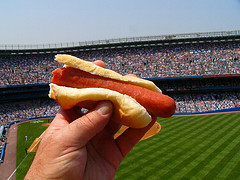When I turned 16 years old my dad and I (below, exactly as shown) took a trip around the somewhat North Eastern U.S. and caught a bunch of baseball games at MLB parks. In the summer, baseball dominated the TV in our house (my dad was a Yankees fan, and in a true reflection of rebellion, I grew up a Mets fan) so this was the trip of a lifetime for both of us.
This was back before the tubes of the Interwebs were in everyone’s homes (we did have a 1200 baud modem on a 486) so getting tickets was tricky. We picked up a
Street & Smith’s baseball preview magazine (complete with schedules and box office contact information) in March and over the Easter weekend planned out the route. We called to order tickets and waited a few weeks.

Setting out on an early July morning, we drove down the 401 (that’s a highway in Ontario) towards our first stop in Montreal listening to mix tapes I had made (my dad was particularly harsh on my Pearl Jam selections). The trip was a true father/son bonding experience and is definitely one of the fondest memories of my childhood. In 9 days we hit games in 7 stadiums (Montreal, Philly, Pittsburgh, Cleveland, Cincy, Detroit and Toronto) without much of a hitch (no rainouts, car troubles or bad seats). I even caught a ball in Cincy, which is still around and Jack has now discovered.
In each of the stadiums my dad and I ate a standard hot dog (to compare and rate) as well as a sample of the local food specialty (
poutine in Montreal,
cheesesteaks in Philly, etc.). I wasn’t the healthiest eating teenager.
Like it was for my dad and I, food is a big part of the stadium experience for many. In a perfect intersection between two of my passions,
ESPN’s Outside The Lines magazine show focused half an episode on food safety at the 107 major sports stadiums in Canada and the U.S., telling a not-so-flattering story.
ESPN’s "Outside the Lines" reviewed health department inspection reports for food and beverage outlets at all 107 North American arenas and stadiums that were home to Major League Baseball, National Football League, National Hockey League and National Basketball Association teams in 2009. At 30 of the venues (28 percent), more than half of the concession stands or restaurants had been cited for at least one "critical" or "major" health violation. Such violations pose a risk for foodborne illnesses that can make someone sick, or, in extreme cases, become fatal.
Bob Buchanan, food safety guru, was cited as saying:
"That number [the 30 venues with a majority of food establishments having critical violations], based on comparisons of the data I’ve been able to find on restaurants in general, is substantially higher than I would have expected. Certainly, if you have a high rate of facilities within a stadium coming up with critical deficiencies, that to me strikes of systemic errors in either management of the stadium or in the infrastructure of the stadium, and both of them need to be corrected."
Bang on Bob; practices are related to the culture within the organization from the manager’s attitude all the way to the front-line staff.

Steven Weiss, of Aramark, one of the stadium food providers focused on in the story was quoted as saying,"The most important thing for people to know is that food safety is our top priority. There’s nothing more important." That’s a great start, but unless everyone in the organization knows and values food safety in the same way food safety slips down the priority list, and as Bob said, bad practices can become systemic. And investigative reporters will find the multiple and repeated transgressions.
Our
food safety infosheet evaluation study also made the companion piece on the website, supporting something an ex-frontline food handler Nicholas Casorio said, "There’s so much volume going through at one time that it’s hard to do the necessary things to keep everything clean. Sometimes you sacrifice the cleanliness for expediting the service."
Last fall I took my dad to a Carolina Hurricanes game and we debated getting a bbq sandwich after the first period but the price tag was a bit steep ($7). My dad asked me "So, how do you think they are doing, food safety-wise".
I told him that it’s tough to say, anytime you eat you put trust in a food handler somewhere and hopefully they know somthing about risks and risk reduction. After the game I dug up some inspection reports. I couldn’t find the Carolina BBQ stand in question but was able to browse through 20 or so other RBC Center sites from the past couple of years. Temperature abuse, especially hot-holding seemed to be a common violation.
The bbq looked and smelled good, and judging by the lineups, was moved out of the pans to patrons’ sandwiches pretty fast. But who knows at what temperature, and how long it was held before we came by. I hope that someone did.

 Steven Weiss, of Aramark, one of the stadium food providers focused on in the story was quoted as saying,"The most important thing for people to know is that food safety is our top priority. There’s nothing more important." That’s a great start, but unless everyone in the organization knows and values food safety in the same way food safety slips down the priority list, and as Bob said, bad practices can become systemic. And investigative reporters will find the multiple and repeated transgressions.
Steven Weiss, of Aramark, one of the stadium food providers focused on in the story was quoted as saying,"The most important thing for people to know is that food safety is our top priority. There’s nothing more important." That’s a great start, but unless everyone in the organization knows and values food safety in the same way food safety slips down the priority list, and as Bob said, bad practices can become systemic. And investigative reporters will find the multiple and repeated transgressions.